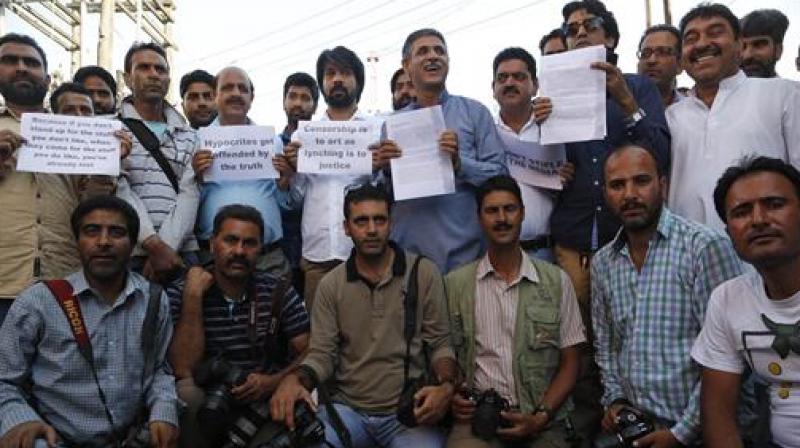New policy and policing methods combined with various prohibitive action has made journalism a particularly difficult profession to have in Kashmir.
Junaid Kathju
The raid at the residences of four Kashmiri journalists in the wee hours of September 9 might be seen as a jolt to the fourth pillar of democracy elsewhere in the world. In a conflict-torn Kashmir, however, it is the new normal that the journalistic fraternity is facing after the government of India took direct control of the former state, following the reading down of its special status on August 5, 2019.
In the past two years, more than 20 journalists in Kashmir have either been called for a background check, summoned, or raided; they are being forced to present themselves to explain their stories, social media conduct and other societal behavior.
According to sources, the police department has created various sections that are currently monitoring and profiling Kashmir-based journalists, most of whom work for either national or international media outlets.
Sources said that one such section, called “Dial 100”, works on the “background updation” of journalists, which includes verifying their entire professional career in the media, including their body of work, family relations, foreign travels, and so on.
“In the background updation [process], a phone call goes out to journalists where they are either asked to visit the CID branch in the police station of their area or the investigative officer asks them to meet at a neutral place to collect their details,” a source familiar with the process said.
Sources said the other wing of the investigation is called the “Ecosystem of Narrative Terrorism” in which, apart from journalists, the profiling of human rights activists, civil society, lawyers, academics, and other associated people, is being carried out.
Sources said that, in this investigation, officials largely focus on the body of work of the people related to their respective fields.
“Here the officials minutely check the body of work of the particular individual. Like in [case of] lawyers, the investigative officer checks the kind of cases they take up. Similarly, in journalists’ [cases], an officer checks the stories they are doing,” the source said. “After the investigation is complete, the cases are then being sent to the higher authority to take a call on them.”
Some of the senior journalists who were summoned post-August 5, 2019, include Hindu correspondent Peerzada Ashiq, the Economic Times correspondent Hakeem Irfan, Basharat Masood of the Indian Express, and Outlook correspondent Naseer Ganai, among others.
Most of these journalists were questioned about their stories and social media activities.
The raid at the residences of four Kashmiri journalists in the wee hours of September 9 might be seen as a jolt to the fourth pillar of democracy elsewhere in the world. In a conflict-torn Kashmir, however, it is the new normal that the journalistic fraternity is facing after the government of India took direct control of the former state, following the reading down of its special status on August 5, 2019.
In the past two years, more than 20 journalists in Kashmir have either been called for a background check, summoned, or raided; they are being forced to present themselves to explain their stories, social media conduct, and other societal behavior.
According to sources, the police department has created various sections that are currently monitoring and profiling Kashmir-based journalists, most of whom work for either national or international media outlets.
Sources said that one such section, called “Dial 100”, works on the “background updation” of journalists, which includes verifying their entire professional career in the media, including their body of work, family relations, foreign travels, and so on.
“In the background updation [process], a phone call goes out to journalists where they are either asked to visit the CID branch in the police station of their area or the investigative officer asks them to meet at a neutral place to collect their details,” a source familiar with the process said.
Sources said the other wing of the investigation is called the “Ecosystem of Narrative Terrorism” in which, apart from journalists, the profiling of human rights activists, civil society, lawyers, academics and other associated people, is being carried out.
Sources said that, in this investigation, officials largely focus on the body of work of the people related to their respective fields.
“Here the officials minutely check the body of work of the particular individual. Like in [case of] lawyers, the investigative officer checks the kind of cases they take up. Similarly, in journalists’ [cases], an officer checks the stories they are doing,” the source said. “After the investigation is complete, the cases are then being sent to the higher authority to take a call on them.”
Some of the senior journalists who were summoned post-August 5, 2019, include Hindu correspondent Peerzada Ashiq, the Economic Times correspondent Hakeem Irfan, Basharat Masood of the Indian Express, and Outlook correspondent Naseer Ganai, among others.
Most of these journalists were questioned about their stories and social media activities.
“It is very difficult for journalists in Kashmir to operate. It is almost impossible. There is so much surveillance, so many different ways of harassment,” Bhasin said.
Bhasin noted that it is complete, unannounced censorship on media in Kashmir, “where the government is intolerant to even one critical word.”
“It [the government] has completely silenced journalism. But there are some brave journalists who are writing and are struggling to write and, as long as their struggle continues, journalism in Kashmir is not completely dead,” she said.
Bhasin said the suppressive attitude of the government has created an atmosphere of mistrust, even among journalists in the valley.
“To some extent, we [journalists] have not been united as there is an atmosphere where even journalists are not sure who is on whose side and that makes it difficult for the fraternity to come together as a cohesive unit. I can’t totally blame them because there is so much regression and suppression at the moment. There are various ways of arm-twisting,” she said.
A senior editor in one of the leading local newspapers, requesting anonymity, said that the new media policy has reduced the local newspapers to an unofficial “media wing” of the government.
“If you analyze all the newspapers post-August 5, 2019, you won’t even find a single story against the performance of the administration,” the senior editor said. “The moment you write anything critical against the government, either your advertisements are suspended or you are being summoned.”
In June last year, the Union government introduced a new media policy that gives the administration unabated power to censure independent reporting.
One of the points mentioned in the policy reads, “There shall be no release of advertisements to any media which incite or intend to incite violence, question sovereignty and integrity of India, or violate the accepted norms of public decency and behavior.”





